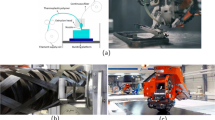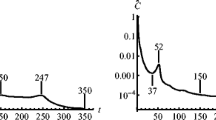Abstract
In a recent publication, an approach to optimize the orientation of anisotropic materials was presented. This strategy was embedded into the thermodynamic topology optimization based on growth. In this paper, we show that the thermodynamic orientation optimization can also be used in more classical approaches to topology optimization. We furthermore enhance the approach by a novel filtering technique to provide control over the smoothness of the pathway of principal material directions, i.e., the curvature of fibers. The filter is based on a convolution operator and is applied to the material stiffness tensor, so that the filtering technique is not directly bounded to the actual parameterization for the design variables. To this end, the topology is defined by a continuous density approach with penalization of intermediate densities (SIMP) solved via the optimality criteria method (OCM). A set of three continuous Euler angles is used as additional design variables to describe the local material rotation of the anisotropic base material. The thermodynamic optimization of the material orientation is performed by evolution of the Euler angles to minimize the elastic energy. The related evolution equations are derived by means of the Hamilton principle, well-known from material modeling.






















Similar content being viewed by others
Notes
This dependence could be removed by filtering the rotated base material tensor \(\mathbb {E}^{\mathrm {R}}\) instead of the effective material tensor \(\mathbb {E}\).
We tested our material orientation optimization for a homogenous density distribution without filtering: the results coincide with the principal stress direction with a relative compliance difference less then 0.5%
A monolithic solution for the displacements and the design is not considered here which would result in a solution via an iterative non-linear FEM with increased number of degrees of freedom, and thus a more complex implementation. However, a monolithic solution could improve the convergence behavior and may require less iterations resulting in an overall reduced calculation time.
The element-wise design variables are extrapolated to the nodes of the FE mesh and the isosurface for \(\hat {\chi } = 0.5\) of the linear interpolated density field is shown.
References
Bedford A (1985) Hamilton’s principle in continuum mechanics, Vol. 139, Pitman Advanced Publishing Program
Bendsøe MP, Sigmund O (2003) Topology optimization: theory, methods and applications. Springer
Berdichevsky V (2009) Variational principles of continuum mechanics: I. Fundamentals Springer Science & Business Media
Blasques JP, Stolpe M (2012) Multi-material topology optimization of laminated composite beam cross sections. Compos Struct 94(11):3278–3289
Brampton CJ, Wu KC, Kim HA (2015) New optimization method for steered fiber composites using the level set method. Struct Multidiscip Optim 52(3):493–505
Capecchi D, Ruta G (2010) A historical perspective of Menabrea’s theorem in elasticity. Meccanica 45 (2):199–212
Cowin SC, Mehrabadi MM (1987) On the identification of material symmetry for anisotropic elastic materials. Q J Mech Appl Math 40(Part 4):451–476
Deaton JD, Grandhi RV (2014) A survey of structural and multidisciplinary continuum topology optimization: post 2000. Struct Multidiscip Optim 49(1):1–38
Gaganelis G, Jantos DR, Mark P, Junker P (2019) Tension/compression anisotropy enhanced topology design. Struct Multidiscip Optim 59(6):2227–2255
Gea H, Luo J (2004) On the stress-based and strain-based methods for predicting optimal orientation of orthotropic materials. Struct Multidiscip Optim 26(3-4):229–234
Hackl K (1999) On the representation of anisotropic elastic materials by symmetric irreducible tensors. Contin Mech Thermodyn 11(6):353–369
Hamilton WR (1834) On a general method in dynamics; by which the study of the motions of all free systems of attracting or repelling points is reduced to the search and differentiation of one central relation, or characteristic function. Philosophical transactions of the Royal Society of London 124:247–308
Hamilton WR (1835) Second essay on a general method in dynamics. Philos Trans R Soc Lond 125:95–144
Haslinger J, Kocvara M, Leugering G, Stingl M (2010) Multidisciplinary free material optimization. SIAM J Appl Math 70(7):2709–2728
Hoglund R, Smith D (2016) Continuous fiber angle topology optimization for polymer fused filament fabrication. In: Proceedings of the 27th annual international solid freeform fabrication symposium, austin, TX, USA, pp 8–10
Honda S, Igarashi T, Narita Y (2013) Multi-objective optimization of curvilinear fiber shapes for laminated composite plates by using nsga-ii. Composites Part B: Engineering 45(1):1071–1078
Hörnlein H, Kočvara M, Werner R (2001) Material optimization: bridging the gap between conceptual and preliminary design. Aerospace Science and Technology 5(8):541–554
Hvejsel CF, Lund E (2011) Material interpolation schemes for unified topology and multi-material optimization. Struct Multidiscip Optim 43(6):811–825
Jantos DR, Hackl K, Junker P (2019) An accurate and fast regularization approach to thermodynamic topology optimization. Int J Numer Methods Eng 117(9):991–1017
Jantos DR, Junker P, Hackl K (2016) An evolutionary topology optimization approach with variationally controlled growth. Comput Methods Appl Mech Eng 310:780–801
Jantos DR, Junker P, Hackl K (2018) Optimized growth and reorientation of anisotropic material based on evolution equations. Comput Mech 62:47–66. https://doi.org/10.1007/s00466-017-1483-3
Junker P (2014) A novel approach to representative orientation distribution functions for modeling and simulation of polycrystalline shape memory alloys. Int J Numer Methods Eng 98(11):799– 818
Junker P, Hackl K (2014) A thermo-mechanically coupled field model for shape memory alloys. Contin Mech Thermodyn 2014 :1–19
Junker P, Hackl K (2015) A variational growth approach to topology optimization. Struct Multidiscip Optim 52(2):293–304
Junker P, Jaeger S, Kastner O, Eggeler G, Hackl K (2015) Variational prediction of the mechanical behavior of shape memory alloys based on thermal experiments. Journal of the Mechanics and Physics of Solids 80:86–102
Junker P, Schwarz S, Jantos D, Hackl K (2019) A fast and robust numerical treatment of a gradient-enhanced model for brittle damage, International Journal for Multiscale Computational Engineering
Klarbring A, Torstenfelt B, Hansbo P, Larson MG (2017) Optimal design of fibre reinforced membrane structures. Struct Multidiscip Optim 56(4):781–789
Kočvara M, Stingl M (2007) Free material optimization for stress constraints. Struct Multidiscip Optim 33(4):323–335
Li F-Y, Li L-Y, Dang Y, Wu P-F (2018) Study of the effect of fibre orientation on artificially directed steel fibre-reinforced concrete, Advances in Materials Science and Engineering
Mazumdar S (2001) Composites manufacturing: materials, product, and process engineering. CRC Press
Mehrabadi MM, Cowin SC (1990) Eigentensors of linear anisotropic elastic materials. The Quarterly Journal of Mechanics and Applied Mathematics 43(1):15–41
Mu R, Li H, Qing L, Lin J, Zhao Q (2017) Aligning steel fibers in cement mortar using electro-magnetic field. Construct Build Mater 131:309–316
Niu B, Olhoff N, Lund E, Cheng G (2010) Discrete material optimization of vibrating laminated composite plates for minimum sound radiation. Int J Solids Struct 47(16):2097–2114
Nomura T, Dede EM, Lee J, Yamasaki S, Matsumori T, Kawamoto A, Kikuchi N (2015) General topology optimization method with continuous and discrete orientation design using isoparametric projection. Int J Numer Methods Eng 101(8):571–605
Pedersen P, Pedersen NL (2017) Optimized constitutive distributions visualized by lamina formulas. Mech Adv Mater Struct 24(5):385–391
Petrovic M, Nomura T, Yamada T, Izui K, Nishiwaki S (2018) Orthotropic material orientation optimization method in composite laminates. Struct Multidiscip Optim 57(2):815–828
Pulte H (1989) Das Prinzip der Kleinsten Wirkung Und Die Kraftkonzeptionen der Rationalen Mechanik Eine Untersuchung Zur Grundlegungsproblematik Bei Leonhard Euler. Pierre Louis Moreau de Maupertuis Und Joseph Louis Lagrange, Steiner Verlag
Rion V, Bruyneel M (2006) Topology optimization of membranes made of orthotropic material, Collection of Papers from Prof. Nguyen Dang Hung’s Former Students, pp 107–120
Sigmund O (2001) A 99 line topology optimization code written in Matlab. Structural and Multidisciplinary Optimization 21(2):120–127. https://doi.org/10.1007/s001580050176
Sigmund O (2007) Morphology-based black and white filters for topology optimization. Structural and Multidisciplinary Optimization 33(4):401–424. https://doi.org/10.1007/s00158-006-0087-x
Sigmund O, Maute K (2013) Topology optimization approaches. Struct Multidiscip Optim 48(6):1031–1055
Sigmund O, Petersson J (1998) Numerical instabilities in topology optimization: a survey on procedures dealing with checkerboards, mesh-dependencies and local minima. Structural optimization 16(1):68–75
Slabaugh GG (1999) Computing euler angles from a rotation matrix. Retrieved on August 6(2000):39–63
Sørensen R, Lund E (2015) In-plane material filters for the discrete material optimization method. Struct Multidiscip Optim 52(4):645–661
Stegmann J, Lund E (2005) Discrete material optimization of general composite shell structures. Int J Numer Methods Eng 62(14):2009–2027
Stuelpnagel J (1964) On the parametrization of the three-dimensional rotation group. SIAM Rev 6(4):422–430
Tekinalp HL, Kunc V, Velez-Garcia GM, Duty CE, Love LJ, Naskar AK, Blue CA, Ozcan S (2014) Highly oriented carbon fiber–polymer composites via additive manufacturing. Compos Sci Technol 105:144–150
Zowe J, Kočvara M, Bendsøe MP (1997) Free material optimization via mathematical programming. Mathematical Programming 79(1):445–466
Acknowledgments
The authors gratefully acknowledge financial support through the ZIM project with grant number AiF-ZIM (ZF4620401US8).
Author information
Authors and Affiliations
Corresponding author
Ethics declarations
Conflict of interest
The authors declare that they have no conflict of interest.
Additional information
Responsible Editor: Ming Zhou
Publisher’s note
Springer Nature remains neutral with regard to jurisdictional claims in published maps and institutional affiliations.
Replication of results
All results can be reproduced by following the program structure in the flowchart in Fig. 1 and the parameters provided in Section 3.1. No additional information is needed.
Rights and permissions
About this article
Cite this article
Jantos, D.R., Hackl, K. & Junker, P. Topology optimization with anisotropic materials, including a filter to smooth fiber pathways. Struct Multidisc Optim 61, 2135–2154 (2020). https://doi.org/10.1007/s00158-019-02461-x
Received:
Revised:
Accepted:
Published:
Issue Date:
DOI: https://doi.org/10.1007/s00158-019-02461-x




